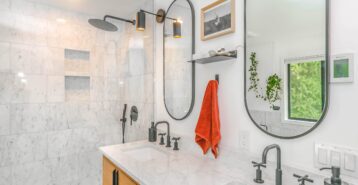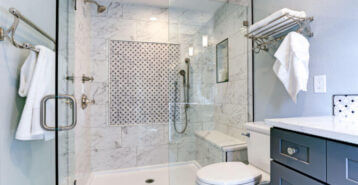Standard Shower Sizes
There are several “standard” sizes for showers, depending on the location and type of shower. For instance, a corner shower is likely to be much smaller than an alcove shower and certainly smaller than the dimensions of a walk-in shower. Choosing what type of shower you want to add to your bathroom will help you figure out what size you will need. From the smallest shower sizes of 30 inches by 30 inches (the smallest allowed by the International Residential Code) to showers bigger than the already generous 48 inches by 60 inches, the shower size you choose will impact your comfort, lifestyle, and more.
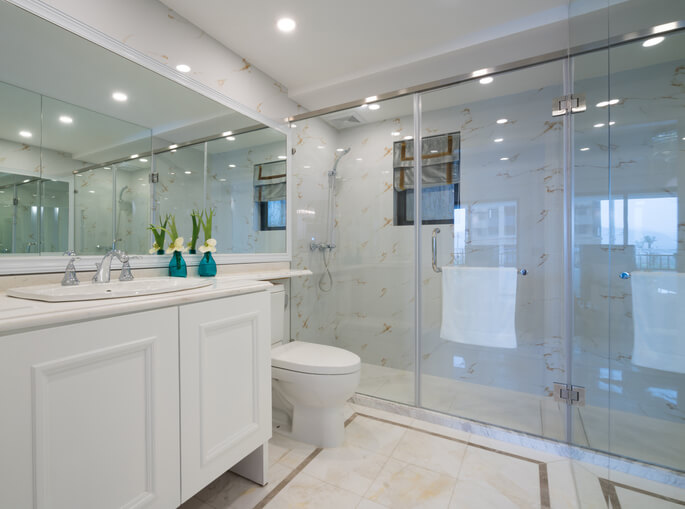
The typical alcove shower or shower-tub combo is 36 inches wide by 60 inches long, but this isn’t a universal standard. Different shower styles — such as walk-in, roll-in, and corner showers — each come with their own common dimensions.
When choosing the right shower size, start by considering your bathroom’s overall layout. A good rule of thumb is to stand inside the planned shower footprint, extend your arms, and slowly turn in a circle. If that space feels comfortable and fits within your layout, it’s likely a good size for your remodel.
If you don’t have room for a 36 × 60 unit, most people still feel comfortable in a 48 × 36-inch shower. A 32 × 32-inch shower is considered the minimum practical size — slightly tight for some, but functional in small bathrooms.
Here’s a brief rundown of standard shower sizes by type:
| Type of shower | Standard size |
|---|---|
| Small prefabricated shower | 32" wide by 32" deep |
| Large prefabricated shower | 36" wide by 60" deep |
| Small shower-tub combo | 60" wide by 30" deep by 70" tall |
| Large shower-tub combo | 60" wide by 36" deep by 72" tall |
| Small walk-in shower | 60" wide by 30" deep |
| Large walk-in shower | 60" wide by 42" deep |
| Corner shower | 32" wide by 32" deep |
| Large ADA compliant shower | At least 36" wide by 36" deep |
Walk-in Shower Dimensions
When you are designing your own walk-in shower, the only restriction on size is what your bathroom can handle. Walk-in showers can be as large or small as you want, but there are a few common dimensions:
- Square: 36” x 36” or 42” x 42”
- Rectangular: 60” x 30” or 60” x 42”
Professional shower installers recommend a walk-in shower size of 36 inches by 36 inches at the smallest to ensure there is ample space. Square shaped walk-in showers are often considered the most space-conscious. However, if you are looking to add a shower bench, a rectangular shower is probably a better option.
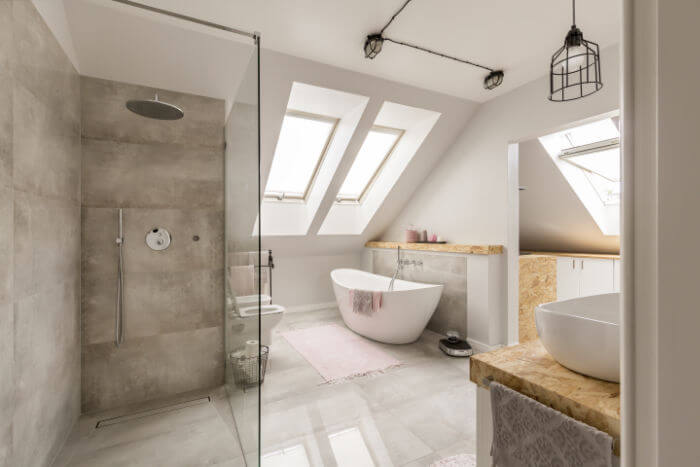
One thing to keep in mind when creating a walk-in shower is the placement of the showerheads. Too few or too small showerheads in a very large space brings the risk of being uncomfortably cold during your shower, or the water not reaching all the areas it should. Make sure you have an ample number of showerheads for a larger walk-in.
Stand-up Shower Dimensions
The most common dimensions for a freestanding shower are 36 inches by 60 inches. Smaller freestanding shower dimensions are typically 36 inches by 36 inches, which is best for smaller bathrooms or when adding a shower to a half bath. For a mid-size freestanding shower, 42 inches by 42 inches is a popular option.
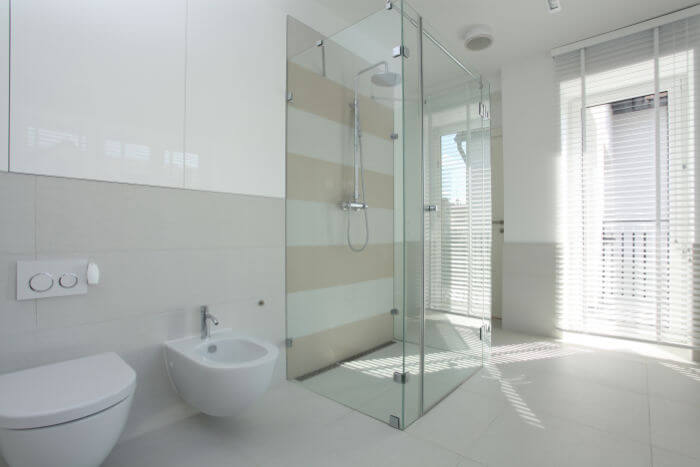
Keep in mind that the shower size you need can vary widely depending upon the size of your bathroom and how much space you want to use. Many homeowners choose to go with the existing footprint of their shower when going through a bathroom remodel, so your stand-up shower dimensions will rely on the previous size.
Shower/Tub Combo Dimensions
A shower–bathtub combo generally requires more space than a standalone shower. The two most common sizes are:
- Smaller Combo: 60 in. × 30 in. × 72 in.
- Larger Combo: 60 in. × 36 in. × 72 in.
The only difference between the two is width, but both are larger than a standard bathtub. If you’re upgrading from a tub-only setup, don’t rely on bathtub dimensions alone. A combo unit needs additional room.
For the enclosure, you can choose sliding glass doors or a shower curtain. Tension rods work for almost any shower width, while fixed rods require precise measurement. Shower curtains should be the width of your shower plus about 12 inches to allow for smooth movement.
What is the Smallest Shower Size?
The smallest possible shower size is 32 inches by 32 inches. Some homeowners wonder if a 32 x 32 shower is too small. It is pretty tiny and can be uncomfortable for longer showers. However, plenty of homeowners or renters use and make this size work. It might not be suitable for those who are tall or carry extra weight, though. A compromise is a bit larger standard shower size of 36 inches by 36 inches, or even 42 inches by 42 inches.
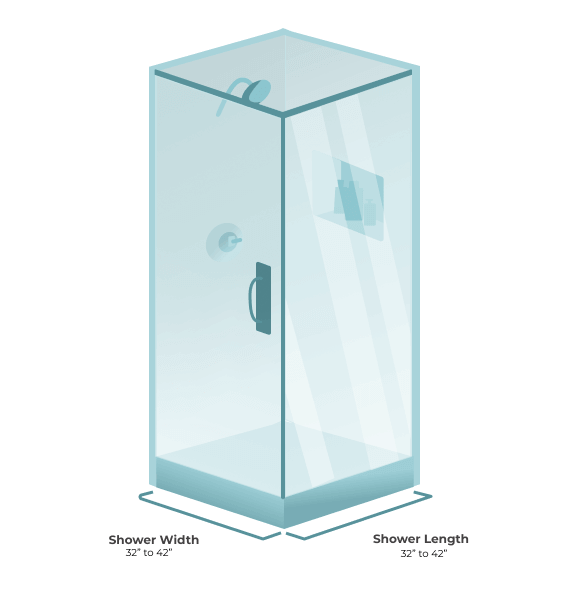
Either way, these tiny showers are typically situated in the corner of the bathroom. Corner showers are good options for smaller bathrooms when needing to conserve space.
Keep in mind that you might have to be creative with the type of shower door you choose. Depending upon the space, a neo-angle or curved shower door might be the best option.
Standard Shower Base Sizes
The shower base, also known as the shower pan, is a prefabricated base, usually made with acrylic or fiberglass, that houses the drainage plumbing for your shower. Shower pan standard sizes are 32 inches by 32 inches or 36 inches by 36 inches. These are shower base sizes for either a walk-in shower or a typical shower enclosure. The smallest possible shower pan size is 30 inches by 30 inches.
Standard Shower Door Sizes
Most shower doors sizes are anywhere from 22 inches to 36 inches wide, but it depends on the type of door. The most common shower door types are the sliding glass door and hinged shower door. Here are their standard sizes:
- Sliding glass shower door: 45” to 59” wide
- Hinged shower door: 22” to 36” wide
Sliding doors are the most common in shower/tub combinations but might also be found in stand-alone showers. These shower doors are typically wider due to the nature of how they function: they need to enclose the entire width of the shower and tub unit. Sliding glass shower doors typically run up to 60 inches wide.
The hinged shower door style is the more common for the freestanding shower. The standard for hinged doors is 26 inches in width, but can run up to 36” wide or more for larger showers.
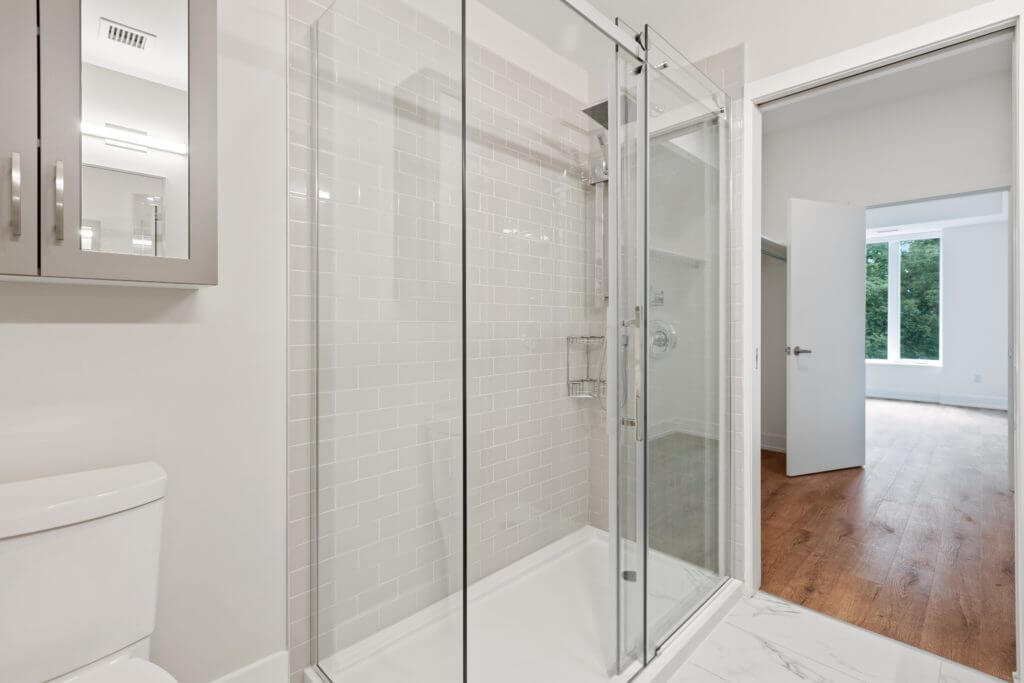
The smallest shower door size you might want to consider is 22 inches wide. Anything smaller might be difficult to use. Going up to 36 inches is within the usual standard size, but you might go wider with a custom built shower. To avoid a shower door altogether, consider using a shower curtain or creating a walk-in shower.
Shower Bench Sizes
A luxurious yet practical addition to your shower is a bench. Sometimes a prefabricated shower unit will come with a bench built into the unit itself. Those that are installed in the shower after the fact are usually 18 inches tall with varying lengths, depending on the footprint of the shower. A good rule of thumb is that a bench should be twice the length of the shower, and a shower chair can be suitable at 15 inches.
ADA-Compliant Shower Sizes
If you require a shower that is compliant with the standards of the Americans with Disabilities Act (ADA), a shower of at least 36 inches by 36 inches meets the ADA criteria for a shower. Keep in mind that there are two possible shower options that comply with ADA guidelines: transfer showers and roll-in showers.
- Transfer showers are designed to allow wheelchairs to roll next to the shower, then allow the users to transfer from the wheelchair to a shower seat or bench that is mounted on the wall. The dimensions must be at least 36 inches by 36 inches.
- Roll-in showers allow the user to roll their wheelchair fully into the shower. These showers must be 30 inches by 60 inches to be considered ADA-compliant.
How Does Shower Size Impact Shower Remodel Costs?
Shower size has one of the biggest impacts on your remodel cost because most materials — especially tile — are priced per square foot. Shower tile typically ranges from $2 to $16 per square foot, so a larger shower means more material and higher costs. Bigger shower pans and wider glass doors also increase expenses.
Size also affects labor and prep work. Underlayment and waterproofing are priced by the linear foot, and demolition costs rise as the footprint grows. Any added features, such as multiple showerheads, built-in benches, or other custom upgrades, will further increase the total price.
If you want a clearer idea of what your full bathroom remodel may cost, try our calculator below.
Standard Shower Sizes Q&A
What is the standard size for a shower?
The most common standard size for a standalone shower is 36 × 36 inches. Other widely used dimensions include 32 × 32 inches for small bathrooms and 48 × 36 inches for mid-sized showers. Prefabricated shower stalls also commonly come in 60 × 30 inches for tub-to-shower conversions.
What is a good size for a walk-in shower?
A good, comfortable walk-in shower size starts at 48 × 36 inches, though many homeowners prefer 60 × 36 inches or larger for easier movement and accessibility. If you plan to add features like a bench or multiple showerheads, 60 × 42 inches or more is ideal.
Is a 36 × 36 shower too small?
A 36 × 36-inch shower meets most building code minimums and is considered a standard size, but some people find it tight — especially when bending or shaving. It works well in small bathrooms but may feel cramped compared to more modern shower designs.
Is a 36 × 48 shower big enough?
Yes, 36 × 48 inches is considered a comfortable mid-sized shower. It offers noticeably more elbow room than a 36 × 36 and is one of the most popular sizes for walk-in showers that don’t require a large footprint.
What is a comfortable shower size?
Most homeowners find 48 × 36 inches to 60 × 36 inches the most comfortable range. Larger layouts such as 60 × 42 or <strong”>72 × 36 inches provide even more room, accommodate built-in benches, and feel more spa-like without requiring an oversized bathroom.
Expert Contractor Advice
Before choosing a shower type or picking tiles, have a contractor evaluate your bathroom to determine the right shower size for your space. They’ll ask how the shower will be used, who will use it regularly, and whether any accessibility needs should be considered — for example, avoiding very small corner showers for larger users or choosing a roll-in design for wheelchair access.
You’ll also want to factor in storage, lighting, and built-in accessories like shelves or niches. Be upfront about your priorities and ask your contractor to show several layout and sizing options. With professional guidance and standard shower dimensions in mind, you can design a shower that fits your space, your routine, and your budget. Modernize can help connect you with qualified contractors so you can compare quotes before starting your remodel.
Compare top-rated bathroom remodel pros in your area.
Read real homeowner reviews, explore qualifications, and view promotions. Modernize makes it easy to browse professionals and find one that will be perfect for your project.






